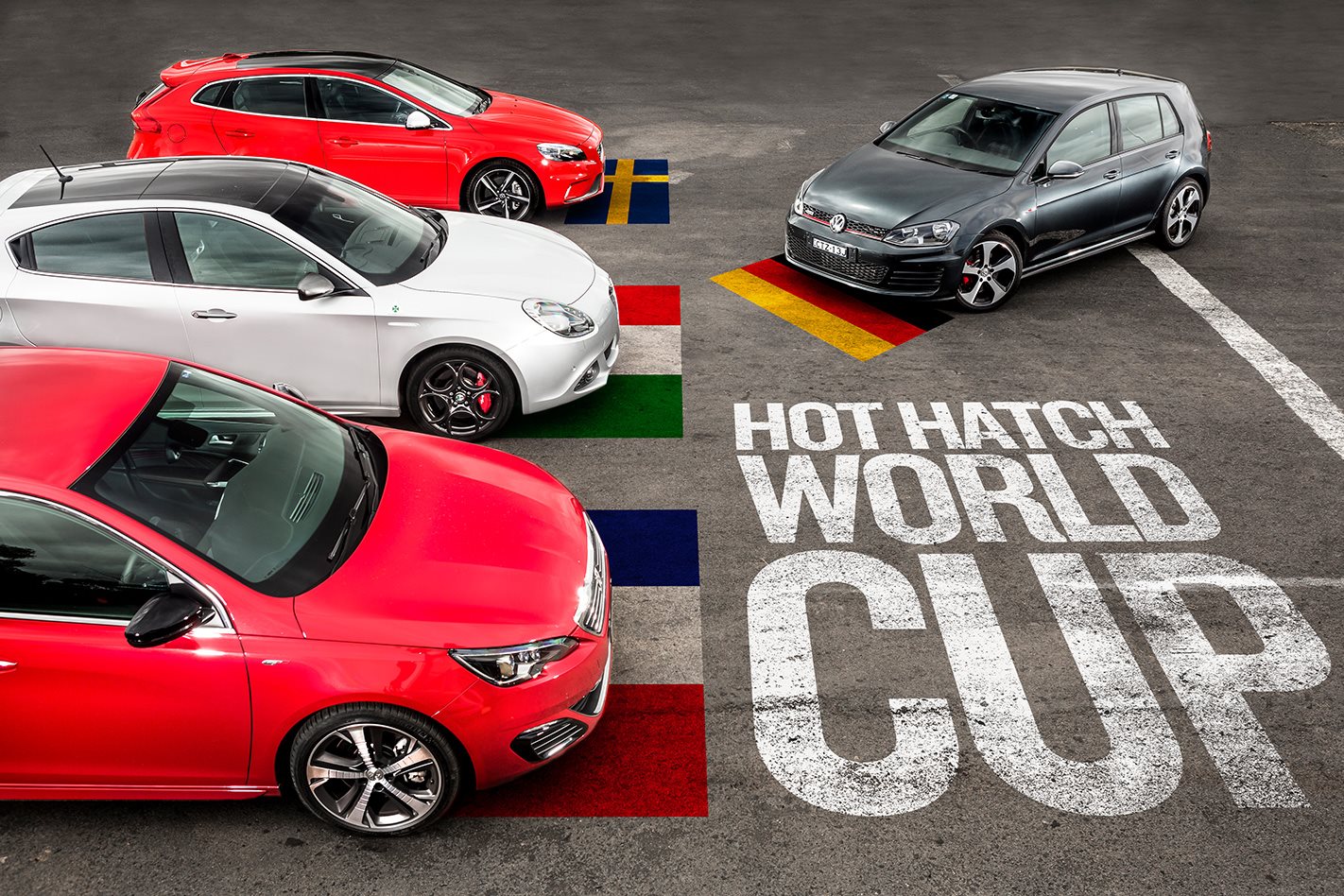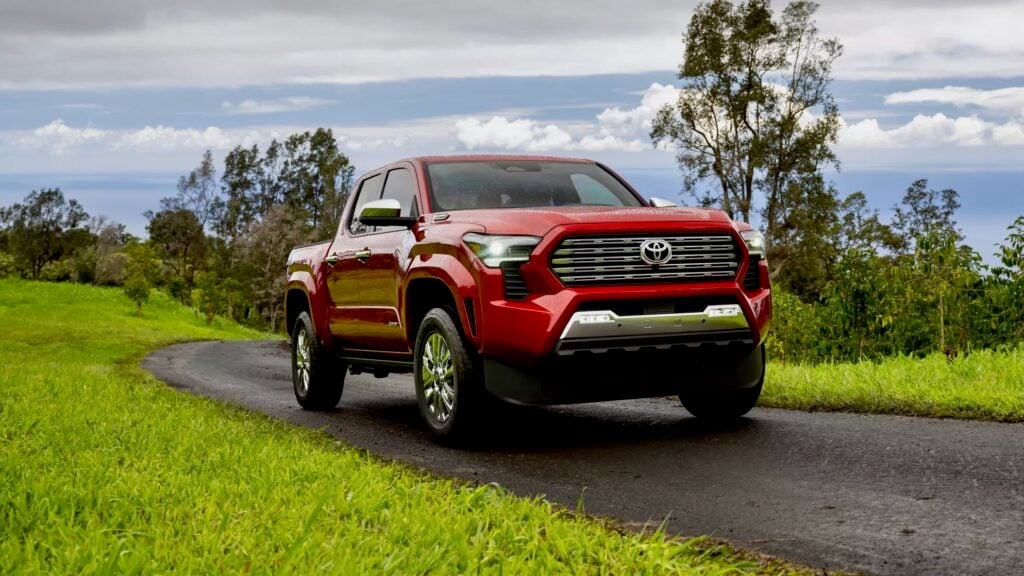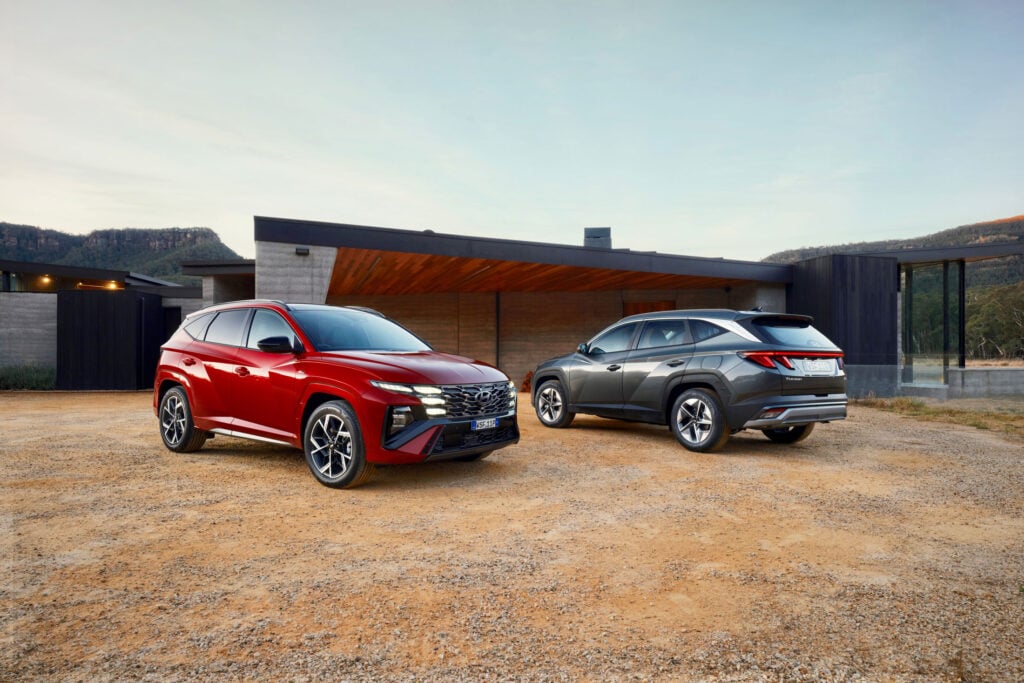Life would be pretty boring if we all liked the same things. You like Coke, I like Pepsi. You like Indian food, I like Mexican. You like Justin Bieber…no, wait, nobody likes Justin Bieber.
Anyway, it means there are plenty of people who won’t go for the obvious choice. Which brings us to the Volkswagen Golf GTI. There’s little argument that it’s the best car in its segment – particularly in MK VII guise, it’s beaten pretty much everything we’ve put it up against.
Judging by regular comments on our social media pages, however, there are plenty of enthusiasts out there who don’t want a Golf, if for no other reason than “everyone’s got one”. Which is fair enough, variety is the spice of life.
But what to buy in that case? To find out we’ve gathered together three premium Euro hatches that, whether on price, performance, or both, position themselves as GTI rivals. A couple of the more obvious contestants aren’t represented here.
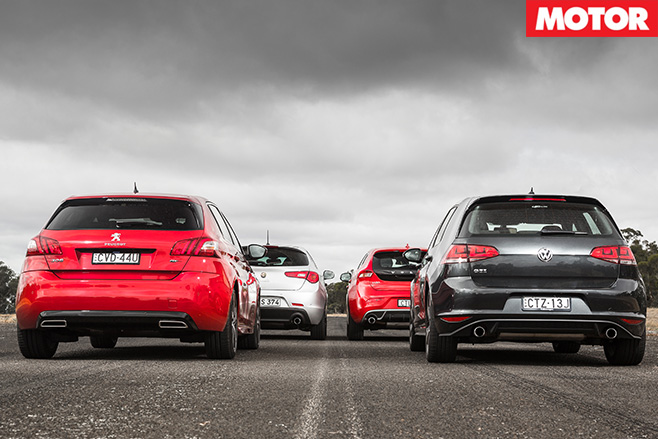
This leaves us with the recently updated Alfa Romeo Giulietta Quadrifoglio Verde in $42,990 dual-clutch TCT form; the similarly facelifted Volvo V40 T5 R-Design, our most expensive contender at $50,400; and the new Peugeot 308 GT, a GTI-matching $41,990 for the manual-only petrol variant.
And, of course, the Golf GTI is here as a benchmark in base manual form, which is arguably the sweetest of all. A motley crew, perhaps, but all are premium hatchbacks with turbocharged four-cylinder engines driving the front wheels.
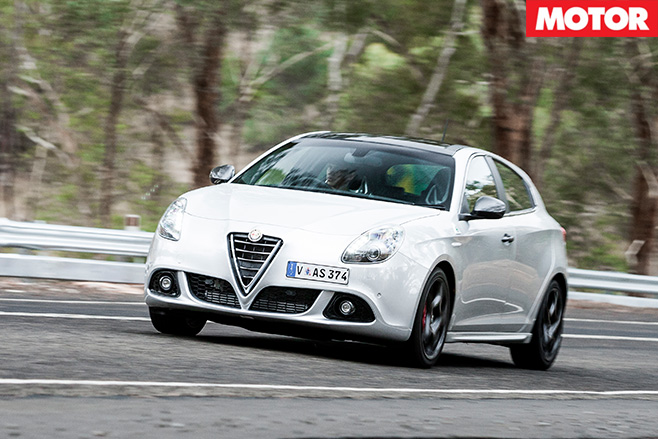
Power increases by only 4kW (the manual, which retains the old alloy engine, continues with 173kW) and torque remains at 340Nm. Both outputs are big numbers from such a small engine, though.
It’s conspicuously turbocharged with a fair amount of lag by modern standards, but the mid-range is incredibly strong. It also sounds suitably angry, particularly from outside, with a deep growl redolent of carb-fed Alfas of old. Unfortunately, the new TCT gearbox is off the pace. It will over-ride manual selections, and downshifts are especially slow.
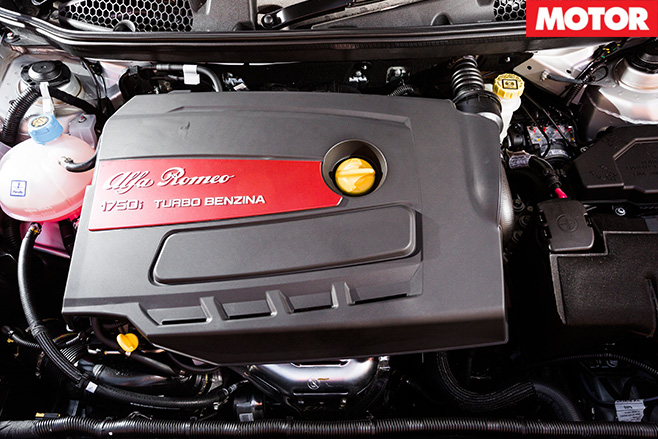
It’s undoubtedly effective, the Alfa matching its 6.0sec 0-100km/h claim time and time again with a best of 6.02sec and a 14.29sec quarter mile at 159.16km/h, making it the fastest of our quartet.
Hot on its heels is the Golf GTI. Clocking 0-100km/h in 6.27sec and crossing the quarter in 14.46sec – the best numbers we’ve managed in a Mk VII GTI – it’s slightly slower, but its 159.99km/h trap speed is a fraction up on the Alfa. In fact, at 160km/h the pair is separated by just 0.01sec. More important than the numbers, though, is the way the VW delivers them.
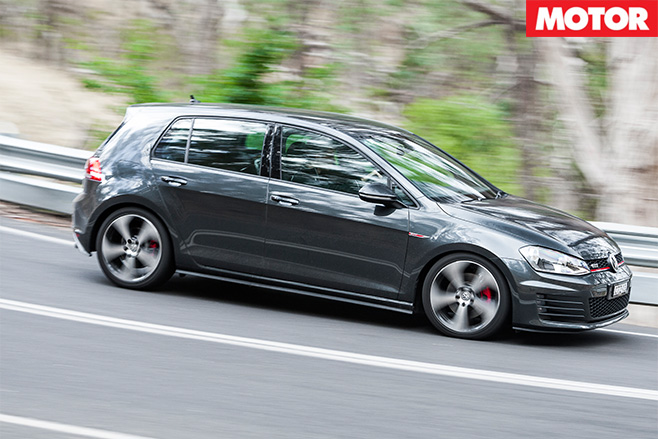
At the other end of the acceleration spectrum is the 308 GT. With its 1.6-litre turbo four producing 151kW and 285Nm, the Peugeot has the smallest engine and the least power and torque, so its drag strip wooden spoon might come as no surprise. A kerb weight of just 1200kg gives it a competitive power-to-weight ratio, though.
It takes a while for the backwards-facing tacho needle – just like an Aston Martin, though the similarities end there – to sweep its way into the red, but the engine is flexible and reasonably responsive. And though some will hate the synthesised engine sound, personally I quite like it.
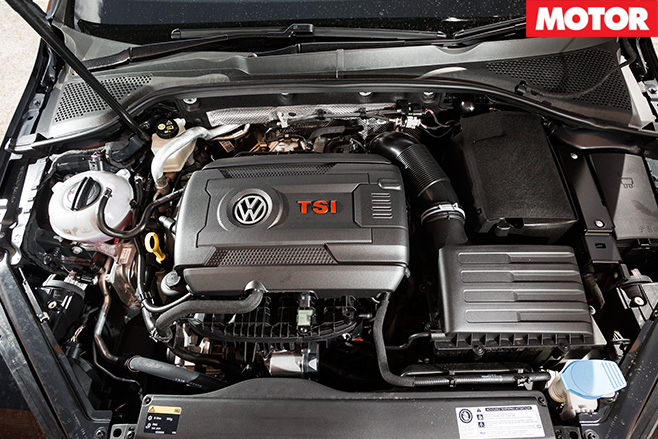
The Volvo’s, however, does not. With 180kW and 350Nm from its new Drive-E 2.0-litre turbo four, it has the highest outputs of any car here, so it’s acceleration times of 6.91sec 0-100km/h and a 15.02sec quarter mile at 153.02km/h are disappointing.
Holding it against the brake spools up 2500rpm, and it launches cleanly with little wheelspin, but despite extremely short gear ratios it’s just not that fast. The culprit? A kerb weight 144kg more than the next-heaviest car (the Golf) and a whopping 268kg more than the lithe Peugeot.
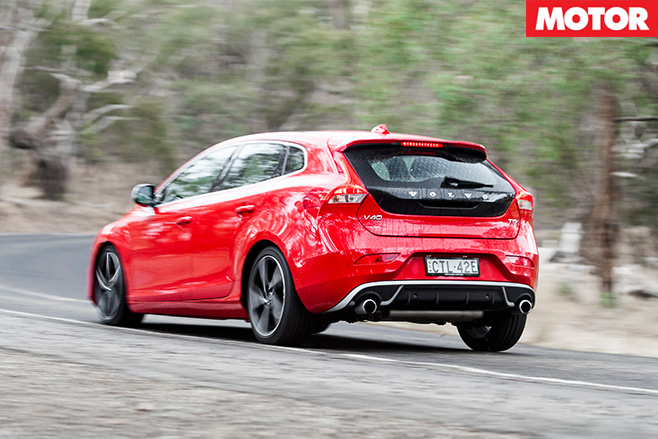
Its cause is not helped by an eight-speed automatic gearbox that, while perfectly acceptable for everyday use, drops the ball when it comes to performance motoring. Downshifts are denied unless less than 4000rpm is showing on the tacho, and the shifts themselves are slow.
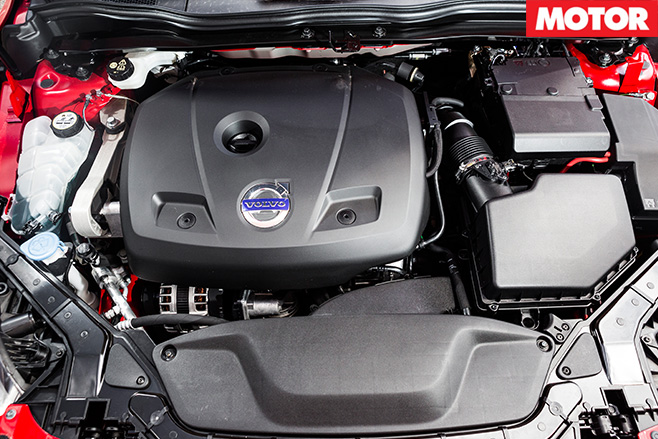
In tighter turns, understeer is the predominant handling characteristic and there’s basically bugger-all you can do about it; this is partly due to an inert chassis and partly due to an ESP system that can’t be disabled.
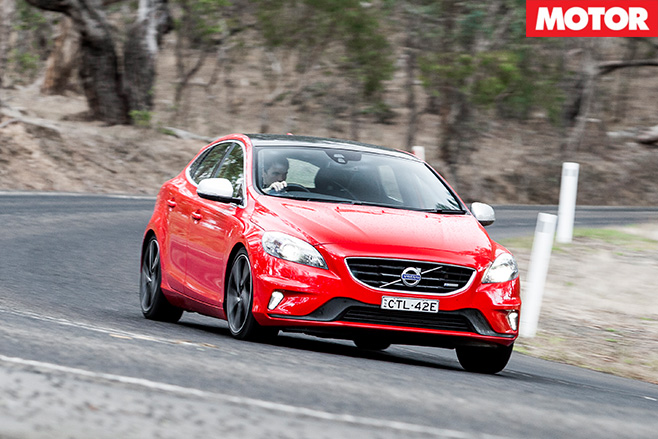
The polar opposite in character is the Giulietta, though it’s arguable whether the Italian is much faster than the Swede over a given section of road. The difference is noticeable from the first turn of the steering wheel; the Alfa’s much faster rack meaning far less lock is required to negotiate any given corner.
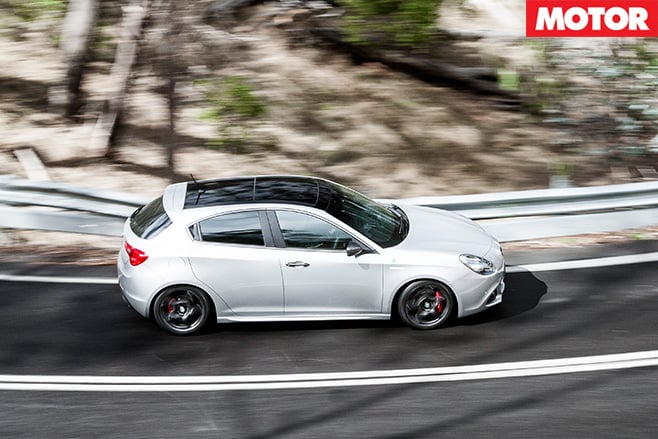
Lateral grip levels are very strong, even in the wet, and the Giulietta is beautifully adjustable using brakes and throttle. Adjustable, that is, until ESP clamps down. While Dynamic mode loosens the reins a little, any keen driver is quickly going to be frustrated that the system cannot be disabled, doubly so because there’s clearly a playful, responsive chassis dying to express itself.
For a manufacturer with the sporting pedigree of Alfa Romeo not to allow ESP to be deactivated is a disgrace. Juan Manuel Fangio would be rolling in his grave if he knew. No such qualms with the Peugeot. Unusually in this day and age, one quick press of the ESP button means you’re driving solo.
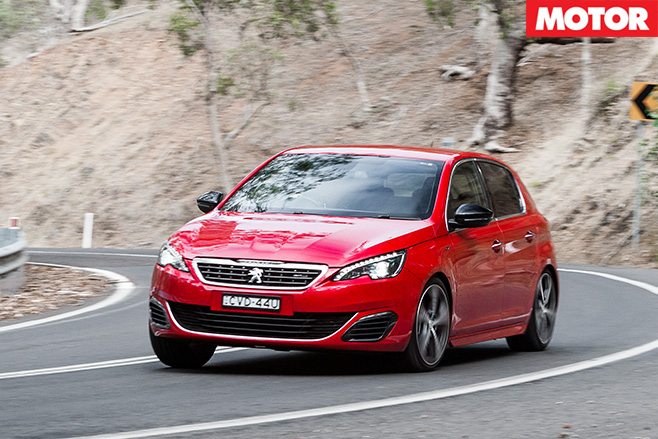
The flipside of this is decent traction; the inside front wheel can spin up when exiting tight corners, but it’s easily controlled and modulated. In general, it’s a very neutral chassis. Understeer is kept in check unless you really go in hot and any attempt to enliven the rear is met with that famous French insouciance. Up to around eight-tenths it’s agile – it only weighs 1200kg, remember – and quick enough, though it’s unlikely to set your heart racing.

In almost every other area, however, the Golf quickly proves why it’s the class benchmark. The steering is maybe a touch on the heavy side, and the quick response of the variable-ratio rack (just two turns lock-to-lock) takes some acclimatisation, but it soon becomes second nature.
The ride is the best here, courtesy of the standard-fit adaptive dampers, and the chassis is the most playful. Like the Alfa, ESP cannot be completely disabled, but the VW’s Sport mode allows greater freedom to the point where it’s unlikely to interfere too often on the public road. Track-day goers will curse it, though.
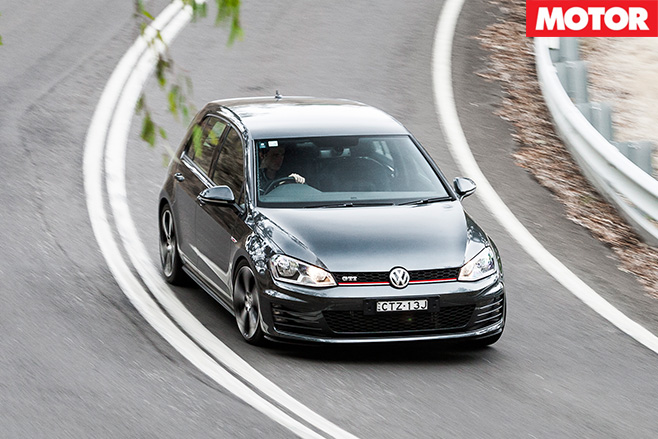
Still, it’s more James Bond than James Hunt in its choice of attire, a theme that continues on the inside. However, while the mood may be sombre, enlivened only by flashes of red stitching and the excellent tartan seats, the materials are high quality, the driving position perfect and it’s well equipped.
Still, if it’s design flair you’re after, the Alfa might be more your shot of espresso. Credit must go to whoever specced this particular press car, as the silver paint contrasted with black roof and wheels looks sensational. The nose is a bit Sam the Eagle from The Muppets, but in general the Giulietta is a very attractive car.
Inside there are neat touches like Italian script on the water (acqua), fuel (benzina) and rev (giri) gauges, cool rotary HVAC controls with digital readouts in the middle, and it wins points for retaining a manual handbrake.
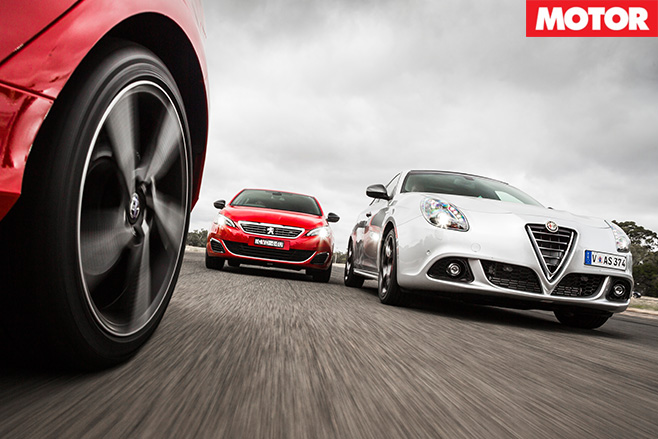
The 308 continues Peugeot’s current trend of mounting the miniature steering wheel low enough so that the dials can be read over the top. It’s meant to significantly assist refocusing after a glance at the instruments, and in this case it works because, unlike Peugeot’s 208, the driver’s seat is mounted low in the car, meaning the wheel is still high enough not to feel like you’re driving with your knees.
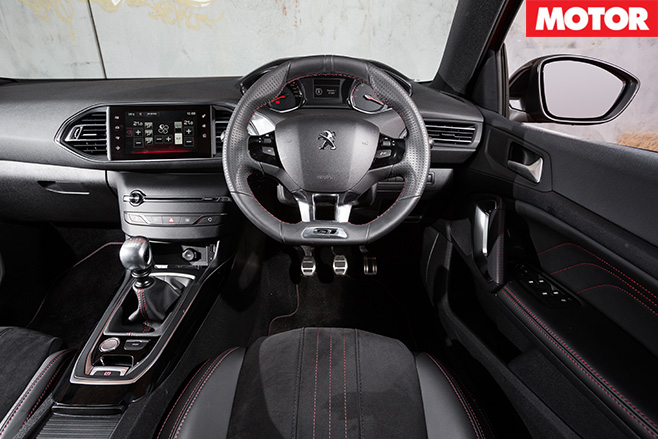
The Peugeot’s looks split opinion, with editor DC calling it fussy, while I think it looks squat and handsome, bar the strange crinkly bonnet that makes it look like the car has already been in a minor accident.
Mind you, if you were going to have an accident, the Volvo is probably the car to have it in. It feels like it’s built like a tank. In contrast to the minimalist Peugeot, the V40’s centre stack is a button fest and it takes time and familiarity to learn what each press, turn and poke does.
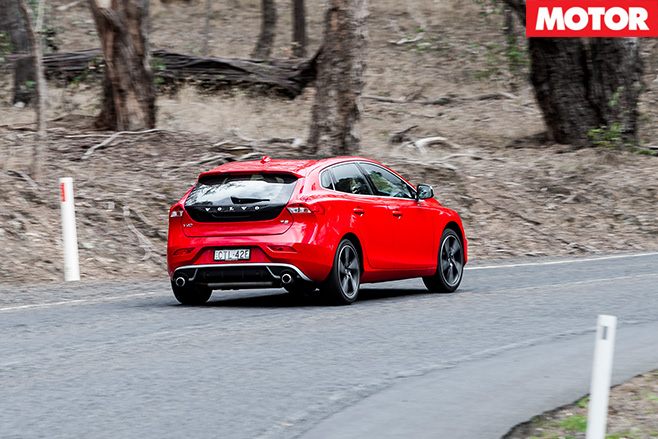
In objective terms, the Golf GTI is the clear winner of this lot – it’s the best car in almost every area. The other three have different strengths in different areas, and as such are likely to appeal to different buyers for different reasons.
Sadly, the Volvo falls first as it just doesn’t feel like a particularly sporty product. It’s like its dynamic ability is an accident, which is quite ironic given how hard the car works to prevent you from having one. It’s not a bad car by any means, but from an enthusiast’s standpoint it’s not that fast, not that inspiring to drive, and it’s also the priciest car here by quite a margin.
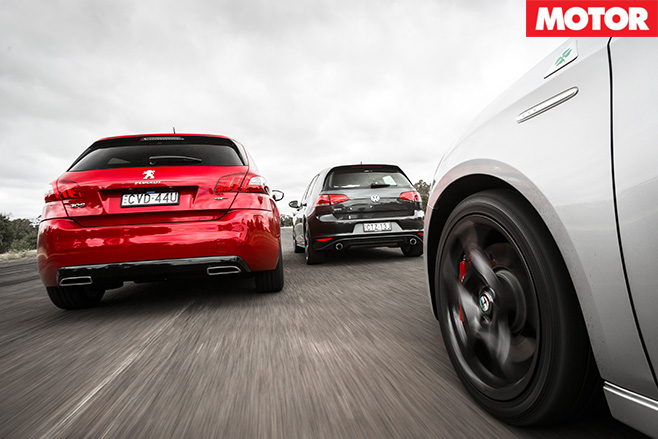
However, it’s the 308 that gets the nod as best of the rest. It may be the slowest car here, but it’s actually the most enjoyable to drive hard and continues Peugeot’s recent resurgence – it’s far better than some of the recent dross the brand has marketed as performance metal. If only it was a bit faster.
The basis is there, now Peugeot Sport needs to get its hands on the 308 and stuff it full of RCZ-R bits – then it’ll have a hot hatch to best not just the GTI, but the Performance Pack as well. And that’s something everyone will like.
| u00a0 | Peugeot 308 GT | Alfa Giulietta QV | Volvo V40 T5 | VW Golf GTI |
| Body | 5-door, 5-seat hatch | 5-door, 5-seat hatch | 5-door, 5-seat hatch | 5-door, 5-seat hatch |
| Drive | front-wheel | front-wheel | front-wheel | front-wheel |
| Engine | 1598cc inline-4, DOHC, 16v, turbo | 1742cc inline-4, DOHC, 16v, turbo | 1969cc inline-4, DOHC, 16v, turbo | 1984cc inline-4, DOHC, 16v, turbo |
| Bore/Stroke | 77.0 x 85.8mm | 83.0 x 80.5mm | 82.0 x 93.2mm/td> | 82.5 x 92.8mm |
| Compression | 10.5:1 | 9.2:1 | 10.8:1 | 9.6:1 |
| Power | 151kW @ 5000rpm | 177kW @ 5750rpm | 180kW @ 5500rpm | 162kW @ 4500-6200rpm |
| Torque | 285Nm @ 1750-4500rpm | 340Nm @ 1900rpm | 350Nm @ 1500-4800rpm | 350Nm @ 1500-4400rpm |
| Power/Weight | 126kW/tonne | 136kW/tonne | 123kW/tonne | 122kW/tonne |
| Transmission | 6-speed manual | 6-speed dual-clutch | 8-speed auto | 6-speed manual |
| Weight | 1200kg | 1299kg | 1468kg | 1324kg |
| Suspension | struts, coil springs, anti-roll bar (f); torsion beam, coil springs, anti-roll bar (r) | struts, coil springs, anti-roll bar (f); multi-links, anti-roll bar (r) | struts, anti-roll bar (f); multi-links, anti-roll bar (r) | A-arms, adaptive dampers, anti-roll bar (f); multi-links, coil springs, adaptive dampers, anti-roll bar (r) |
| L/W/H | 4253/1804/1447mm | 4351/1798/1465mm | 4369/1802/1445mm | 4349/1799/1491mm |
| Wheelbase | 2620mm | 2634mm | 2647mm | 2620mm |
| Tracks | 1559/1533mm (f/r) | 1554/1554mm (f/r) | 1559/1546mm (f/r) | 1538/1516mm (f/r) |
| Steering | electrically-assisted rack-and-pinion | electrically-assisted rack-and-pinion | electrically-assisted rack-and-pinion | electrically-assisted rack-and-pinion |
| Brakes | 330mm ventilated discs, single-piston calipers (f); 268mm solid discs, single-piston calipers (r) | 330mm ventilated discs, 4-piston calipers (f); 278mm solid discs, single-piston calipers (r) | 320mm ventilated discs, single-piston calipers (f); 280mm ventilated discs, single-piston calipers (r) | 312mm ventilated discs, 4-piston calipers (f); 300mm ventilated discs, single-piston calipers (r) |
| Wheels | 18 x 8.0-inch (f/r) | 18 x 7.5-inch (f/r) | 18 x 7.5-inch (f/r) | 18 x 7.5-inch (f/r) |
| Tyres | 225/40 R18 (f/r) Michelin Pilot Sport 3 | 225/40 R18 (f/r) Dunlop SP Sport Maxx | 225/40 R18 (f/r) Michelin Pilot Sport 3 | 225/40 R18 (f/r) Continental ContiSportContact 2 |
| Price | $41,990 | $42,000 | $50,400 | $41,490 |
| Price as Tested | $41,990 | $42,000 | $53,425* | $41,490 |
| Positives | Grippy, neutral handling; high equipment levels | Pace, engine character, grip, style, keen chassisu00a0 | Solid on-road performance, much improved economy | Class benchmark u2013 engine, handling and ride all great |
| Negatives | Should be faster, chassis could be more adjustable | Intrusive ESP, ergonomics, doesnu2019t like bumps | Price, needs to be more involving, weight issues | Can struggle for traction, lacks visual flair, little else |
| Star Rating | 3.5/5 | 3.5/5 | 3/5 | 4/5 |


